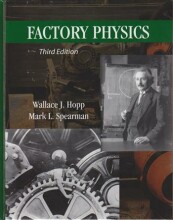Variability Basics - Variability - Queueing
7 important questions on Variability Basics - Variability - Queueing
What is Kendall's notation?
The characterization of a queueing station as: A/B/m/b
In Kendall's notation, what are D, M and G distributions respectively?
D: constant/deterministic
M: exponential (Markovian)
G: general distributions (i.e. normal, uniform)
Factory Physics defines Pn to be the long-run probability of finding the system in state n (i.e., with a total of n jobs in process and in queue). These probabilities are only meaningful in a specific situation. Which?
In a steady state situation. After the system has been running so long that the current state does not depend on the starting conditions).
- Higher grades + faster learning
- Never study anything twice
- 100% sure, 100% understanding
What does an M/D/4/20 queueing system refer to?
To a four-machine station with exponentially distributed interarrival times and with deterministically distributed process times that has a buffer of 20 jobs.
What is the queueing system for a single-machine system where the machine is fed by many different other machines, has an infinite buffer and where process times have the following stochastic distribution: p(30)=0,2 ; p(31)=0 ; p(32)=0,3 ; p(33) = 0,4 and p(34)=0,1 where p(x) denotes the chance of a process time of x seconds happening.
M / G / 1 (infinite buffer)
(The arrival process described is a typical poisson process. The interarrival times of a poisson process are exponentially distributed. The distribution of process times are stochastic -> 'general distribution'.)
True or false?
The VUT equation as in 8.25 describes CTq for all A/B/m queueing stations with an infinite buffer.
False. It is only correct for A/B/1 stations with an infinite buffer. The VUT in 8.29 is correct for all A/B/m stations with infinite buffer.
True or false?
WIP = 4 for an M/M/1 station with u = 0,8.
False. It will only be 4 (on average) in the long run.
The current text-decorationstate might be completely different.
After all, this is the very nature of variability, which still applies to the M/M/1 queue.
(It might seem there is no variability in the M/M/1 queue because the V-term in the VUT equation doesn't show, but that is just the result of CVa and CVe equalling 1. And as long as a CV does not equal 0, there is variability.)
The question on the page originate from the summary of the following study material:
- A unique study and practice tool
- Never study anything twice again
- Get the grades you hope for
- 100% sure, 100% understanding
































